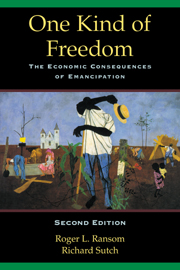Book contents
- Frontmatter
- Contents
- Preface
- Preface to the new edition
- Acknowledgments
- A note to the reader
- Chapter 1 What did freedom mean?
- Chapter 2 The legacy of slavery
- Chapter 3 The myth of the prostrate South
- Chapter 4 The demise of the plantation
- Chapter 5 Agricultural reconstruction
- Chapter 6 Financial reconstruction
- Chapter 7 The emergence of the merchants' territorial monopoly
- Chapter 8 The trap of debt peonage
- Chapter 9 The roots of southern poverty
- STATISTICAL APPENDIXES
- Appendix A Construction of income and welfare estimates: 1859–1899
- Appendix B Occupational distribution of southern blacks: 1860, 1870, 1890
- Appendix C Estimates of labor supplied by slave and free labor
- Appendix D Calculation of interest charged for credit implicit in the dual-price system
- Appendix E Calculation of food residuals on southern farms: 1880
- Appendix F Estimates of per capita gross crop output: 1859–1908
- DATA APPENDIX
- Epilogue
- A Bibliography of Literature on the South after 1977
- Notes
- Bibliography
- Index
Appendix E - Calculation of food residuals on southern farms: 1880
Published online by Cambridge University Press: 05 October 2013
- Frontmatter
- Contents
- Preface
- Preface to the new edition
- Acknowledgments
- A note to the reader
- Chapter 1 What did freedom mean?
- Chapter 2 The legacy of slavery
- Chapter 3 The myth of the prostrate South
- Chapter 4 The demise of the plantation
- Chapter 5 Agricultural reconstruction
- Chapter 6 Financial reconstruction
- Chapter 7 The emergence of the merchants' territorial monopoly
- Chapter 8 The trap of debt peonage
- Chapter 9 The roots of southern poverty
- STATISTICAL APPENDIXES
- Appendix A Construction of income and welfare estimates: 1859–1899
- Appendix B Occupational distribution of southern blacks: 1860, 1870, 1890
- Appendix C Estimates of labor supplied by slave and free labor
- Appendix D Calculation of interest charged for credit implicit in the dual-price system
- Appendix E Calculation of food residuals on southern farms: 1880
- Appendix F Estimates of per capita gross crop output: 1859–1908
- DATA APPENDIX
- Epilogue
- A Bibliography of Literature on the South after 1977
- Notes
- Bibliography
- Index
Summary
The estimates of food surpluses and deficits on farms in the Cotton South presented in Table 8.3 are based on new estimates of the seeding practices and feeding practices on small southern farms around 1880. We constructed new estimates because of problems with our own earlier estimates and the inapplicability of the estimates of other writers who have examined self-sufficiency in the antebellum period.
All the estimates in the earlier studies were deliberately biased against the hypotheses being tested. Such biases were introduced as a check against possible overstatement of the authors' cases. The antebellum studies attempted to establish the presence of self-sufficiency, and thus minimized food production and exaggerated consumption. Our earlier postbellum study attempted to demonstrate the absence of self-sufficiency, and therefore we deliberately understated the consumption requirements of the farm. Having demonstrated the absence of self-sufficiency employing extreme assumptions, we wished to construct more realistic estimates for the present study. Nevertheless, where doubt existed concerning actual practice, we have consciously attempted to make conservative judgments which, if they erred, would likely exaggerate food production and understate consumption.
Obviously, farm practices in any period vary a great deal from farm to farm and region to region. In our estimates we have tried to mirror what seem to be the normal habits of the southern cotton farmer who operated a one-family farm, since that class of farms is the focus of our analysis of the lock-in mechanism.
- Type
- Chapter
- Information
- One Kind of FreedomThe Economic Consequences of Emancipation, pp. 244 - 253Publisher: Cambridge University PressPrint publication year: 2001

